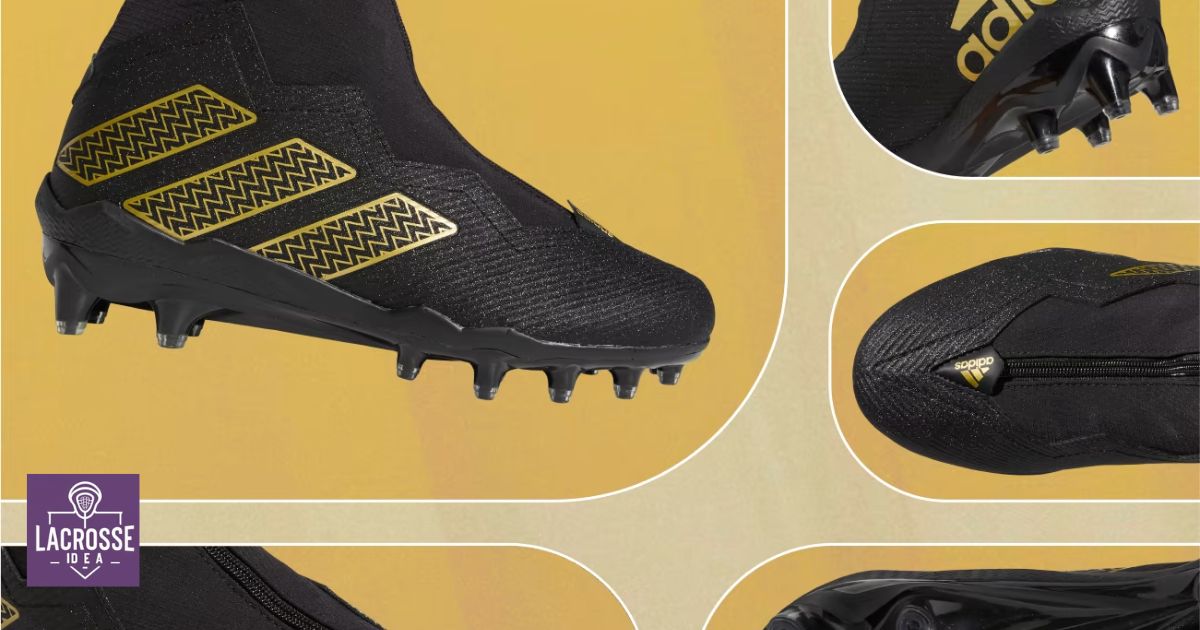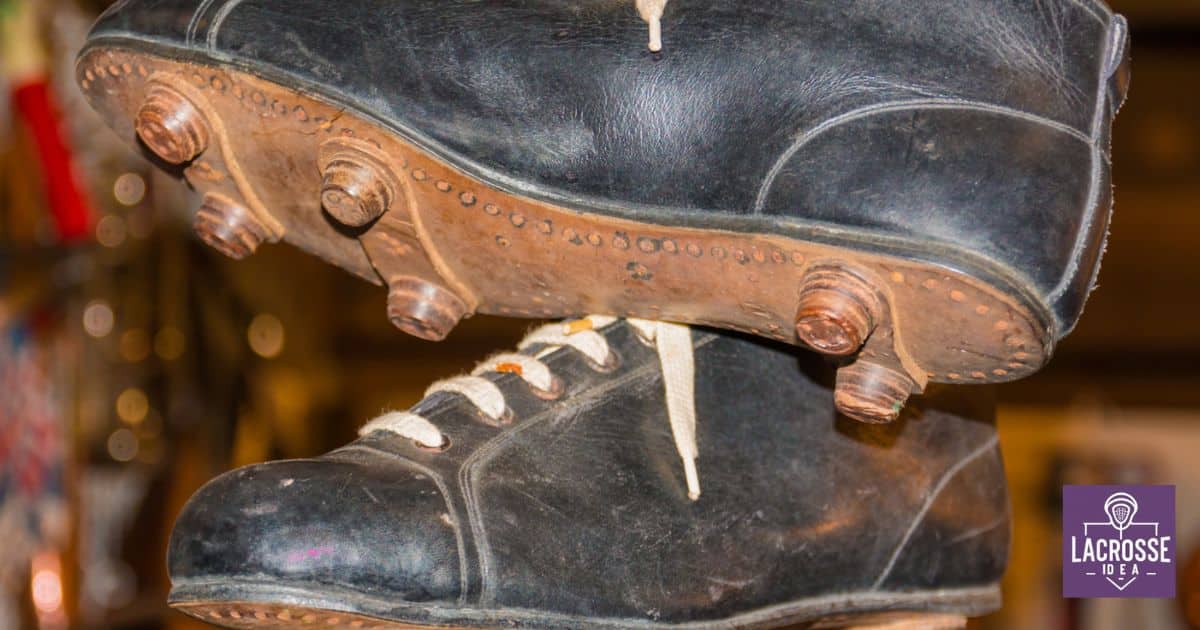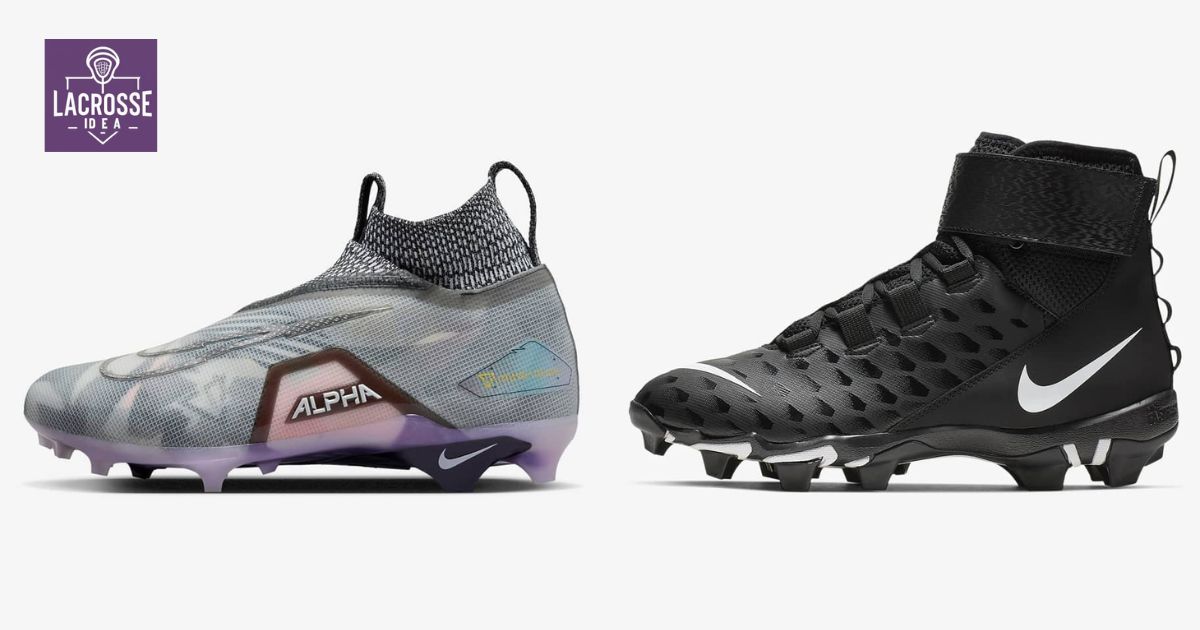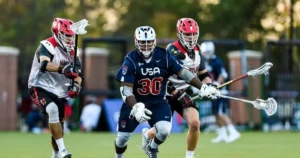Are lacrosse cleats the same as football cleats? As the old saying goes, “not all cleats are created equal.” While both sports require specialized footwear for optimal performance, lacrosse and football cleats have distinct differences that cater to the unique demands of each game. In this article, we will explore the varying factors such as construction, traction, and ankle support that set these cleats apart, helping athletes make informed decisions to enhance their game and belong to their respective sports communities.
Key Takeaways
- Lacrosse cleats have shorter, rubberized studs for traction on turf surfaces, while football cleats often feature longer studs made of metal or plastic for grass fields.
- Lacrosse cleats are typically made of durable and flexible synthetic materials, while football cleats may incorporate leather or synthetic materials based on player preference and position.
- Lacrosse cleats have specific cleat patterns for optimal traction on turf surfaces, with shorter, closely spaced studs, while football cleats have longer studs for stability and traction in various field conditions.
- Lacrosse cleats prioritize impact protection and cushioning, while football cleats focus on ankle support and stability.
Construction And Design
When comparing lacrosse cleats to football cleats, it is important to consider the differences in their construction and design. One key difference is their compatibility with different playing surfaces, particularly turf. Lacrosse cleats are designed with shorter, rubberized studs that provide excellent traction on turf surfaces, preventing slipping and allowing for quick directional changes. Football cleats, on the other hand, often feature longer studs made of metal or plastic, which are better suited for grass fields.
Another significant aspect is the material used in their construction. Lacrosse cleats are typically made of synthetic materials that offer durability and flexibility, allowing players to move freely on the field. Football cleats, in contrast, may incorporate leather or synthetic materials, depending on the player’s preference and position. Understanding these construction and design differences is essential for choosing the appropriate cleats for each sport.
Traction And Cleat Pattern
When it comes to traction and cleat pattern, lacrosse cleats and football cleats have specific differences that cater to the demands of each sport. Traction for turf is essential in both sports, but the cleat patterns differ to optimize performance. Understanding these sport-specific differences in traction and cleat pattern is crucial for athletes to excel in their respective sports.
Traction For Turf
While lacrosse cleats and football cleats may share some similarities, one important area where they differ is in traction for turf, specifically in terms of traction and cleat pattern. Turf compatibility is a crucial factor to consider when choosing the right cleats for playing lacrosse or football on artificial turf. Lacrosse cleats are designed with a specific cleat pattern that provides optimal traction on turf surfaces. These cleats often have shorter, more closely spaced studs to maximize traction efficiency and prevent slipping.
On the other hand, football cleats are designed to provide traction on a variety of surfaces, including natural grass and turf. They typically have longer studs that can penetrate deeper into the ground, offering stability and traction in different field conditions. When it comes to traction for turf, lacrosse cleats are specifically engineered to enhance performance and prevent accidents on artificial turf surfaces.
Different Cleat Patterns
One key difference between lacrosse cleats and football cleats can be seen in their distinct cleat patterns, which greatly impact traction on various playing surfaces. The cleat patterns of lacrosse cleats are designed specifically for the demands of the sport, while football cleats are tailored to the needs of football players. Here are four aspects of cleat patterns that highlight the differences between lacrosse and football cleats:
- Surface-specific traction: Lacrosse cleats are designed with patterns that provide optimal traction on both natural grass and turf surfaces. Football cleats, on the other hand, are engineered to excel on grass fields, with deeper and more widely spaced studs for enhanced grip.
- Agility and quick movements: Lacrosse cleats often feature smaller and more numerous studs, allowing for quick changes in direction and precise footwork. Football cleats, on the other hand, prioritize stability and power, with larger studs that provide a solid base for explosive movements.
- Cleat customization: Lacrosse cleats offer more options for customization, allowing players to choose different stud lengths and configurations based on their playing style and the conditions of the field. Football cleats, while customizable to some extent, tend to have more standardized cleat patterns.
- Cleat maintenance: Due to the nature of lacrosse, which involves more running and agility movements, lacrosse cleats tend to accumulate more debris and require more frequent cleaning and maintenance compared to football cleats. Football cleats, designed for a sport with less running and tackling, are generally easier to clean and maintain.
Understanding the differences in cleat patterns can help lacrosse and football players choose the right footwear for their respective sports. Whether it’s the agility-focused design of lacrosse cleats or the stability and power-oriented construction of football cleats, having the appropriate traction can enhance performance and reduce the risk of injury.
Sport-Specific Performance Differences
The sport-specific performance differences between lacrosse cleats and football cleats can be observed in their traction and cleat pattern designs. Lacrosse cleats are designed to provide optimal traction on different surfaces commonly found on lacrosse fields, such as grass, turf, and dirt. These cleats typically feature a combination of shorter studs and strategically placed traction zones to enhance grip and maneuverability.
In contrast, football cleats are designed to provide traction on grass and turf commonly found on football fields. They often have longer studs to penetrate the surface and provide stability during quick cuts and changes of direction. Additionally, lacrosse cleats may prioritize impact protection and cushioning to support the intense physical demands of the sport, while football cleats may focus more on ankle support and stability to withstand the high-impact collisions common in football.
Ankle Support And Stability
Lacrosse cleats and football cleats differ in their ability to provide consistent ankle support and stability during athletic movements. Ankle stability is crucial in both sports as it helps prevent injuries and allows athletes to perform at their best. When comparing the two types of cleats, here are four key factors to consider:
- Design: Lacrosse cleats are designed with a higher cut to provide additional ankle support. This helps to stabilize the ankle joint during quick lateral movements and sudden changes in direction.
- Padding: Lacrosse cleats often have more padding around the ankle area, offering extra protection against impact and potential injuries.
- Flexibility: While football cleats prioritize ankle stability, they may restrict range of motion due to their lower cut design. In contrast, lacrosse cleats allow for a greater range of motion, enabling players to execute complex movements more freely.
- Traction: Both types of cleats provide excellent traction, but lacrosse cleats may have deeper and more aggressive tread patterns to enhance stability on various surfaces.
Understanding the differences in ankle support and stability between lacrosse and football cleats is crucial for athletes to choose the right footwear that suits their specific needs and enhances their performance on the field.
Flexibility And Range Of Motion
When comparing the ankle support and stability of lacrosse cleats and football cleats, it is important to consider the impact of flexibility and range of motion on an athlete’s performance. In lacrosse, players require a high level of agility and quick movements on the field. Therefore, lacrosse cleat options prioritize flexibility and range of motion to allow athletes to move freely and swiftly.
These cleats are designed with lightweight materials and flexible soles that enable players to make quick cuts, change direction, and accelerate without restriction. The increased flexibility and range of motion provided by lacrosse cleats allow players to perform at their best and maximize their performance on the field. Transitioning into the subsequent section about ‘durability and longevity’, it is also crucial to consider the durability of these cleats to withstand the demands of intense gameplay.
Durability And Longevity
In terms of durability and longevity, both lacrosse cleats and football cleats are designed to withstand the demands of intense gameplay. However, there are some key differences in their construction and materials that can affect their overall performance and lifespan. Here are four important points to consider when comparing the durability of lacrosse cleats and football cleats:
- Material Quality: Lacrosse cleats are often made with high-quality materials such as synthetic leather or mesh, which provide excellent durability and resistance to wear and tear. Football cleats, on the other hand, may use heavier and sturdier materials like genuine leather to withstand the roughness of the sport.
- Cleat Design: Lacrosse cleats typically have a lower profile and are designed to provide agility and quick movements on the field. Football cleats, on the contrary, have a higher cut and are built to offer stability and support during intense tackles and sudden direction changes.
- Stud Configuration: Lacrosse cleats usually feature shorter and more numerous studs, designed to provide optimal traction on grass or turf surfaces. Football cleats, on the other hand, have longer and fewer studs, which offer better traction on different playing surfaces, including grass, turf, and even artificial turf.
- Intensity of Gameplay: While both sports involve quick movements and intense gameplay, football is often more physically demanding and can put more strain on the cleats. As a result, football cleats are generally built to withstand more impact and provide greater durability.
Considering these durability comparisons and performance differences, it is essential to choose the right cleats that align with your specific sporting needs and preferences. Whether you are a lacrosse player or a football enthusiast, having durable and long-lasting cleats will contribute to your overall performance and enjoyment on the field.
Price Range And Availability
When it comes to price range and availability, lacrosse cleats and football cleats offer different options for athletes. Lacrosse cleats are specifically designed for the sport and may have a narrower range of choices compared to football cleats, which are more widely available. Additionally, the price of lacrosse cleats may vary depending on the brand and features, making it important for players to consider their budget when making a purchase.
Lacrosse Cleat Options
The price range and availability of lacrosse cleats vary greatly. When it comes to lacrosse cleat options, there are several factors to consider. Here are four key aspects that can evoke a sense of belonging and excitement for lacrosse players:
- Different Cleat Patterns: Lacrosse cleats come in various patterns, including molded, turf, and detachable cleats. Each pattern offers unique benefits and traction on different playing surfaces, allowing players to choose the option that best suits their playing style and field conditions.
- Price Range: Lacrosse cleats can range from affordable options for beginners to high-end models for professional players. This range ensures that players of all levels can find cleats that fit their budget and meet their performance needs.
- Brand Diversity: There are numerous brands that specialize in lacrosse cleats, offering a wide selection of styles, technologies, and features. This diversity provides players with the opportunity to find a brand that resonates with them and offers the performance and style they desire.
- Availability: Lacrosse cleats are widely available both online and in sporting goods stores. This accessibility ensures that players can easily find and purchase the cleats they need, no matter their location.
With a variety of options, price ranges, and availability, lacrosse players can find the perfect cleats that make them feel like a part of the lacrosse community and enhance their performance on the field.
Football Cleat Availability
With regards to the availability and price range, football cleats offer a wide selection of options for players. Football cleat brands such as Nike, Adidas, and Under Armour dominate the market, providing athletes with numerous choices to suit their specific needs.
These brands are known for their high-quality materials, innovative designs, and advanced technologies that enhance performance on the field. Whether players prefer a traditional stud configuration or a more specialized design for specific positions, football cleats offer a variety of options to cater to individual preferences. The following table showcases some popular football cleat options:
| Brand | Model | Price Range |
|---|---|---|
| Nike | Vapor Untouchable | $120 – $200 |
| Adidas | Adizero | $100 – $180 |
| Under Armour | Spotlight | $90 – $150 |
As we explore the price comparison between cleats in the next section, it becomes evident that football cleats can vary significantly in cost, providing players with the opportunity to find the perfect balance between quality and affordability.
Price Comparison Between Cleats
In terms of price range and availability, a comparison can be made between lacrosse cleats and football cleats. Here is a list of key factors to consider when comparing the prices of these two types of cleats:
- Cleat material: Lacrosse cleats are typically made with more durable materials, such as synthetic leather or mesh, which can contribute to a higher price point compared to football cleats made with synthetic materials.
- Brand reputation: Well-established brands in both lacrosse and football offer a range of cleats at different price points. Higher-end brands with a strong reputation for quality and performance tend to have higher-priced options, while more affordable options can be found from lesser-known brands.
- Availability: Football cleats tend to have a wider range of options available, given the popularity of the sport. Lacrosse cleats may be slightly less readily available, but they can still be found in specialized stores or online.
- Sales and discounts: Keep an eye out for sales and discounts, as both lacrosse and football cleats may go on sale at certain times of the year, allowing you to find a quality pair at a more affordable price.
With an understanding of the price range and availability of lacrosse and football cleats, let’s now explore the specialized features and technology that set them apart.
Specialized Features And Technology
Lacrosse cleats and football cleats differ in their specialized features and technology. While both types of cleats are designed to enhance performance on the field, they are tailored to meet the specific demands of each sport. Lacrosse cleats are designed to provide stability and support for quick lateral movements, as well as traction on both grass and turf surfaces.
On the other hand, football cleats are built to provide optimal traction for explosive forward movements, as well as support for sudden changes in direction. The table below highlights some of the key specialized technologies and performance differences between lacrosse and football cleats.
| Specialized Features | Lacrosse Cleats | Football Cleats |
|---|---|---|
| Traction | Multi-directional | Forward-focused |
| Upper Material | Lightweight and | Durable and |
| breathable | supportive | |
| Midsole Cushioning | Cushioned | Responsive |
| Ankle Support | High ankle collar | Low ankle collar |
| Outsole Configuration | Cleats and | Cleats and |
| non-marking sole | studs |
Sport-Specific Performance And Adaptability
Sport-specific performance and adaptability is crucial in determining the effectiveness of cleats in different athletic activities. When it comes to sport-specific design, cleats are tailored to meet the specific needs and demands of each sport. Here are four performance differences that highlight the importance of sport-specific cleats:
- Traction: Cleats designed for football are optimized for quick bursts of acceleration and lateral movements, while lacrosse cleats prioritize multidirectional movement and agility on different surfaces.
- Support: Football cleats provide ankle support to withstand the high-impact nature of the sport, whereas lacrosse cleats offer more flexibility and lightweight construction for quick changes in direction.
- Durability: Due to the physicality of football, cleats are built with sturdier materials to withstand constant contact, whereas lacrosse cleats prioritize lightweight materials for speed and maneuverability.
- Stud Configuration: Football cleats have a larger number of studs for better traction on grass, while lacrosse cleats have fewer, strategically placed studs to allow for quick pivots on turf.
Understanding these performance differences is essential for athletes to choose the right cleats for their respective sports, ensuring optimal performance and reducing the risk of injury.
Frequently Asked Questions
Are Lacrosse Cleats Suitable for Playing Football?
Lacrosse cleats may not be suitable for playing football due to design differences. Specialized cleats offer advantages in terms of performance and injury prevention. Using sport-specific cleats is recommended for optimal functionality and safety.
Can Football Cleats Be Used for Playing Lacrosse?
When considering the question of whether football cleats can be used for playing lacrosse, it is important to note that while there may be similarities between the two, each sport has specific footwear requirements.
Do Lacrosse Cleats Provide Enough Ankle Support?
Lacrosse cleats are designed to provide adequate ankle support and traction on various surfaces. They are specifically engineered to meet the demands of the sport, ensuring player safety and performance.
Are Lacrosse Cleats More Flexible Than Football Cleats?
When comparing the flexibility of lacrosse cleats to football cleats, it is important to note that lacrosse cleats tend to be more flexible. This difference in flexibility can impact performance on the field, providing athletes with enhanced agility and maneuverability.
Do Lacrosse Cleats Last Longer Than Football Cleats?
When comparing the durability and performance of lacrosse cleats and football cleats, it is important to consider whether lacrosse cleats last longer than football cleats. Durability and longevity are key factors to consider when investing in sports footwear.
Conclusion
In conclusion, while there are some similarities between lacrosse cleats and football cleats, such as their construction and traction patterns, they also have key differences in terms of ankle support, flexibility, and specialized features. Lacrosse cleats are designed to cater to the specific demands of the sport, offering greater agility and maneuverability. Therefore, it is important for athletes to choose cleats that are specifically designed for their respective sport to ensure optimal performance and adaptability.









